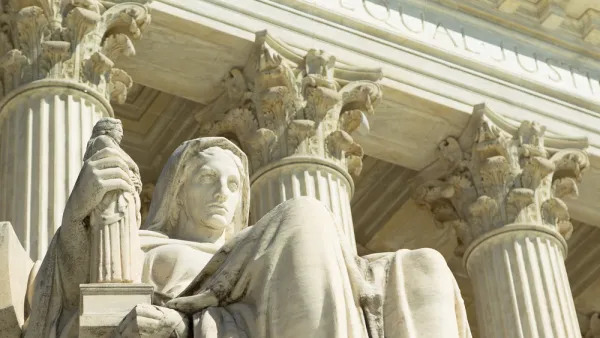The Supreme Court, in two separate opinions, unanimously ruled on June 18 against an Arizona town's sign regulation that denied the placement of a street sign based on its content. At question was a sign directing passers-by to a church service.

"The Supreme Court struck down an Arizona town’s ordinance that treated signs directing people to a small church’s worship services differently than signs with other messages, such as a political candidate’s advertisement," writes Washington Post Supreme Court reporter Robert Barnes.
The [Good News Community Church], which has no permanent home, contended it is being treated differently than politicians, homeowner associations and builders.
The town is fast-growing Gilbert, which had a population of 6,000 in 1980 and an estimated population of 239,000 last year, according to Wikipedia.
"That decision has far-reaching implications for most cities and local governments across the nation, where similar sign regulations will come under renewed scrutiny, experts say," writes Parker Leavitt of The Arizona Republic.
"Local governments across the country view the case as 'one of the most important' to come before the court, according to William Brinton, an authority on sign regulation for local governments who filed a brief in this case on behalf of a large number of municipal government organizations," wrote Nina Totenberg of NPR on Jan. 12, when the Supreme Court heard the case. [Listen here].
Sign regulation is a thorn in the side of local governments. They get sued over these rules all the time, and the lower courts are divided over what constitutional standard to use in evaluating these regulations.
While lawyers for the petitioners viewed the outcome as a victory for religious freedom, "the justices didn't treat it that way," write Richard Wolf and Brad Heath of USA TODAY. "Rather, they said local governments must be able to justify the disparate treatment accorded organizations seeking to spread their messages."
The majority opinion was written by Justice Clarence Thomas, who "said courts must be skeptical of any law that limits speech based on its content, and that sign laws are no exception." A minority opinion, written by Justice Elena Kagan, also ruled against Gilbert, "(b)ut she said the court had gone too far in saying such regulations should receive the court’s most exacting scrutiny," writes Parker.
FULL STORY: Supreme Court rules for church in case against Arizona town’s sign law

National Parks Layoffs Will Cause Communities to Lose Billions
Thousands of essential park workers were laid off this week, just before the busy spring break season.

Retro-silient?: America’s First “Eco-burb,” The Woodlands Turns 50
A master-planned community north of Houston offers lessons on green infrastructure and resilient design, but falls short of its founder’s lofty affordability and walkability goals.

Delivering for America Plan Will Downgrade Mail Service in at Least 49.5 Percent of Zip Codes
Republican and Democrat lawmakers criticize the plan for its disproportionate negative impact on rural communities.

Test News Post 1
This is a summary

Test News Headline 46
Test for the image on the front page.

Balancing Bombs and Butterflies: How the National Guard Protects a Rare Species
The National Guard at Fort Indiantown Gap uses GIS technology and land management strategies to balance military training with conservation efforts, ensuring the survival of the rare eastern regal fritillary butterfly.
Urban Design for Planners 1: Software Tools
This six-course series explores essential urban design concepts using open source software and equips planners with the tools they need to participate fully in the urban design process.
Planning for Universal Design
Learn the tools for implementing Universal Design in planning regulations.
EMC Planning Group, Inc.
Planetizen
Planetizen
Mpact (formerly Rail~Volution)
Great Falls Development Authority, Inc.
HUDs Office of Policy Development and Research
NYU Wagner Graduate School of Public Service





























